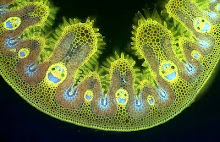Gardening with grasses has become popular in recent years and garden centres are full of examples - many of which, I have to say, look pretty unexciting to me. So I've always been surprised that gardeners don't cultivate some of our cereals, like wheat, rye, oats and the barley Hordeum vulgare pictured above for their decorative properties. Maybe it's just that they are such familiar plants in the landscape, but for sheer architectural beauty they really are very attractive - and the barley variety that I recently found preserved on an old herbarium sheet in Durham University School of Biological and Biomedical Sciences must have been especially so when it was alive and growing.

This particular plant has purple grains. Let me begin by quoting the attached label, that outlines its provenance.
Huskless Barley from Thibet (sic)
This ear of barley was grown at Burton-on-Trent by me in 1890 from seed given by the late Horace T.Brown,F.R.S. He got it from the late Thistleton Dyer, Director of Kew Gardens, who got it from Mr. Duthie of Sharanpur Botanical Gardens. He says the seed came from Poo in Thibet about the year 1881 when it was introduced into the Punjab, with other varieties. Dr. H.T.Brown says in some notes on this barley (Transactions of the Burton Natural History Society), “The colour is not diffused through the paleae, as in black Abyssinian or Scotch barley, but is confined to the integuments of the caryopsis. When microscopically examined, the inner protions of the pericarp immediately adjacent to the testa are seen to be charged with a very dark purple pigment, appearing in mass almost black. This pigment is fairly soluble in water, and probably consists of modified chlorophyll”.......“ The peculiar colour is not confined to the grain only, but occurs also in the nodes of the straw, which even at an early period of growth are very dark purple.” The colour appears to have faded somewhat during all the years that the specimen has been kept. I have tried two or three corns recently but failed to get any sign of germination. John E. Nowers. Jany 9 1928.

Huskless barleys like this, with grains that outgrow the papery glumes that normally enclose them tightly, have been cultivated for at least 8000 years and would have been prized by early farmers because their grains are easily separated from the papery chaff. The great 13th. century traveller Marco Polo, visiting the province of Badashan in what is now part of Afgahistan, mentions the crop:
"The mountains of this country also supply Saker falcons of excellent flight, and plenty of Lanners likewise. Beasts and birds for the chase there are in great abundance. Good wheat is grown, and also barley without husk."
"The mountains of this country also supply Saker falcons of excellent flight, and plenty of Lanners likewise. Beasts and birds for the chase there are in great abundance. Good wheat is grown, and also barley without husk."
When samples were brought to Britain in 1884 by the Mr. Duthie mentioned in the herbarium specimen label above, some were give to John McDougall, the flour miller, for evaluation as a malting grain. He noted that it sprouted well "but the colour comes off and so will not do for pale ales, but it would do well for stout. For feeding purposes it would be useful, although it would take time to remove prejudice for its colour"....
Regretfully Mr. Duthie conceded "The objection as to colour,alluded to in the report, is fatal to its value and will prevent it every being grown, except as a curiosity...."
There was, however, considerable interest in a white-grained variety of the huskless barley, which continues to this day in the malting industry, as evidenced by this research paper published in 2009 entitled 'Potential of Hull-less Barley Malt for use in Malt and Grain Whisky Production'. Huskless barley has come a long way in the last 8000 years.
Meanwhile, I'd love to get my hands on some viable seed of the purple-grained variety, to grow for its decorative properties in my garden.... as a curiosity, as Mr. Duthie suggested back in 1888.
The source of some of the above information is the Bulletin of Miscellaneous Information (Royal Gardens, Kew) No.23, 1888,pp. 271-273, which also contains more detailed information on Dr. Brown's anatomical studies on the grain.
For more on unusual herbarium specimens click here















